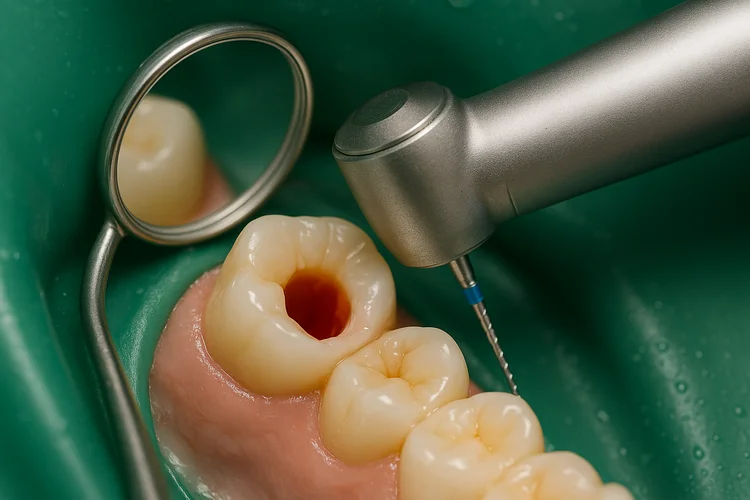Tooth pain that requires a root canal is often sharp, throbbing, and unrelenting. It usually means that the nerve inside the tooth is infected or inflamed, and waiting too long without treatment can exacerbate the situation.
Fortunately, there are several steps you can take to reduce discomfort until your appointment. In this guide, you’ll learn fast, dentist-approved methods to manage pain before your root canal treatment and some other tips for pain relief before root canal treatment.
Over-the-Counter Medications
Non-prescription pain relievers are usually the first step in controlling discomfort before your root canal appointment. The two most effective and widely recommended options are ibuprofen and acetaminophen. Each works differently, and both must be taken with caution.
| Medication | How It Helps | Dosage Guidelines | Precautions |
|---|---|---|---|
| Ibuprofen (Advil, Motrin) | Reduces both pain and inflammation by lowering prostaglandin levels | Adults: 200–400 mg every 4–6 hours as needed (do not exceed 1,200 mg OTC in 24 hours unless prescribed) Children: Pediatric formulations, dosage based on weight | Avoid if you have stomach ulcers, kidney issues, or are on blood thinners. Take with food to prevent irritation. |
| Acetaminophen (Tylenol) | Provides effective pain relief but does not reduce inflammation | Adults: 500–1,000 mg every 6 hours as needed (do not exceed 3,000 mg in 24 hours) Children: Pediatric liquid or chewable forms, dosage based on weight | Safe for most patients but can harm the liver if overdosed. Avoid mixing with alcohol. |
Important Notes:
- Combining ibuprofen and acetaminophen (alternating doses) can provide stronger relief, but only under guidance from your dentist or physician.
- Always inform your dentist of all medications you’ve taken and the time you took them.
- Never give adult-strength medications to children.
When pain is severe, alternating ibuprofen and acetaminophen under guidance can provide stronger relief until you’re seen by an emergency dentist in Scarborough.

Cold Compress Technique for Swelling & Pain
Applying a cold pack to the outside of your cheek for 15-minute intervals helps numb pain and reduce swelling. Cold narrows blood vessels, slowing inflammation and easing pressure in the affected area.
Avoid applying ice directly to the skin. Wrap the pack in a thin towel to prevent irritation. This method offers temporary relief but should be combined with professional care, such as root canal treatment, for long-term results.
Here is what the Healthline website says about cold compresses:
“While most agree that icing and cold compresses may help ease pain in the short term, that’s not a long-term solution, and the benefits of using this type of treatment are largely unstudied.
Your healthcare team can help discuss options if you continue experiencing pain for more than 48 or 72 hours, depending on your injury or situation, and any possible post-care instructions they’ve given you for specific procedures where you might turn to cold compresses afterward.”
Saltwater Rinse to Reduce Bacteria & Inflammation
A warm saltwater rinse can calm irritated tissues and reduce bacteria in the mouth. Mix half a teaspoon of salt in a glass of warm water and swish gently for 30 seconds before spitting.
Repeat this several times a day to keep the area clean and reduce soreness. This is especially helpful if swelling or gum tenderness is present. General dentistry services often recommend this as a safe, at-home step before dental visits.
Avoiding Hot/Cold Foods and Chewing on the Affected Side
In case of severe pain, avoid hot or cold foods and refrain from chewing on the affected side to prevent exacerbating the pain.
Why Temperature Sensitivity Triggers Pain
When the pulp inside a tooth is inflamed or infected, the nerves become hypersensitive. Hot drinks like coffee or cold items such as ice cream can send sharp pain signals directly to the nerve. These flare-ups are a sign that the tooth is severely compromised and requires root canal treatment.
The Role of Chewing Pressure
Chewing on the affected side puts direct pressure on the damaged tooth. This can worsen inflammation, irritate exposed nerves, and even cause cracks in weakened tooth structure. In some cases, food particles may enter through cavities or fractures, increasing the risk of infection.
Best Foods to Eat Before Treatment
Stick to soft, neutral foods that are gentle on your teeth, such as yogurt, scrambled eggs, bananas, pasta, and room-temperature soups. Avoid anything sticky, crunchy, or hard that could aggravate the tooth or cause additional damage.
By minimizing exposure to extreme temperatures and avoiding pressure, you can reduce painful flare-ups and protect the tooth until your appointment with an emergency dentist in Scarborough.

Temporary Dental Fillings or Wax for Exposed Nerves
When a tooth cracks or a filling falls out, the inner nerve may become exposed. This exposure can make the tooth extremely sensitive to air, liquids, and food, often causing sharp pain with every breath or bite. One way to protect the nerve until your appointment is by using a temporary dental filling material, which can be found at most pharmacies. These kits are designed to plug the cavity and provide a short-term seal against irritants.
If a kit isn’t available, orthodontic wax can be softened and carefully placed over the tooth to reduce sensitivity. Even sugar-free chewing gum can serve as a short-lived shield in an emergency. However, it’s important to remember that these solutions are only temporary. The underlying problem, whether it’s infection, nerve damage, or structural weakness, can only be resolved through root canal treatment or a permanent restoration such as a dental crown.
Staying Upright to Reduce Pressure
Tooth pain often intensifies at night, largely because lying flat increases blood flow to the head. This heightened pressure makes inflamed nerves more sensitive and can turn a dull ache into throbbing pain. Adjusting your sleeping position is one of the simplest yet most effective ways to reduce discomfort before your dental visit.
Try using two or more pillows to keep your head elevated, or rest in a reclined chair if lying down worsens the pain. Avoid putting pressure on the affected side, as the added weight of the pillow can aggravate the tooth further. Patients often report better sleep and reduced morning swelling when they keep their head slightly upright through the night. While this technique does not cure the problem, it can make waiting for your appointment more tolerable.
When to Call Your Scarborough Dentist Immediately
While temporary remedies can control symptoms, certain warning signs mean you should seek professional care without delay:
- Severe, unrelenting pain that doesn’t improve with over-the-counter medications.
- Swelling spreading to the face, jaw, or neck may signal a spreading infection.
- Fever or chills suggest the infection is affecting your overall health.
- Difficulty swallowing or breathing can indicate a life-threatening emergency.
If any of these occur, please call our emergency dental care team in Scarborough right away. In extreme cases, such as breathing problems or rapidly increasing swelling, go directly to the hospital ER. Acting quickly prevents complications and ensures you receive the right treatment at the right time.

Preparing for Your Appointment: What to Tell the Dentist
To help your dentist act quickly, be ready to share:
- When the pain began, and how severe it is.
- Which medications or home remedies have you tried?
- Any swelling, fever, or drainage from the gums.
- Relevant medical history or allergies.
This information helps your endodontist or general dentist plan safe and effective treatment, ensuring you get pain relief before root canal therapy as soon as possible.
Need fast relief from tooth pain in Scarborough?
Call Toothwizard today or book an urgent appointment online. Our team provides expert root canal treatment to stop pain at its source.
Fast Relief While Waiting for Professional Care
Managing tooth pain at home is possible, but only a root canal provides lasting relief. Using OTC medications, cold compresses, saltwater rinses, and protective measures can buy you time and ease discomfort.
If you’re struggling with severe pain, contact Toothwizard in Scarborough. We offer same-day appointments for patients requiring urgent root canal treatment to eliminate infection and restore comfort.
FAQ
Patients often wonder what works best at home and what should be left to the dentist. Here are answers to the most common questions for pain relief before root canal therapy.
What painkillers work best before a root canal?
Ibuprofen works best for both pain and inflammation. Acetaminophen is also effective and can be used alone or alternated with ibuprofen.
Does numbing gel help with root canal pain?
Over-the-counter gels can provide temporary surface relief but usually aren’t effective for deep nerve pain that requires a root canal.
Can I eat before root canal treatment?
Yes, unless instructed otherwise. Eat a light meal and avoid alcohol before your appointment. This keeps your energy stable during treatment.
How can I sleep if my tooth pain is severe?
Try staying upright with extra pillows and use OTC painkillers before bed. Avoid cold or hot foods in the evening to reduce flare-ups.
Have you ever managed severe tooth pain before a root canal?
Share your experience in the comments
Your tips may help other Scarborough patients waiting for treatment.

